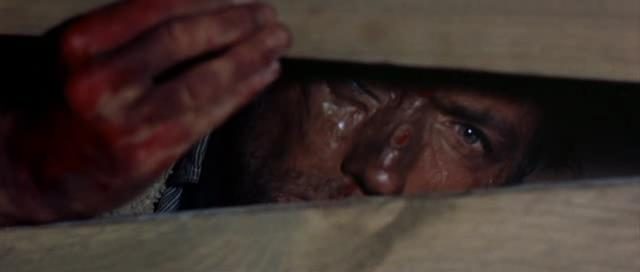“It’s like playing Cowboys And Indians!”
It’s a shame that ‘covers’ aren’t really something you can do in movies. Obviously, it’s something musicians aren’t just able, but encouraged to do; theatre pretty much runs on the idea that the script will be performed a near infinite number of times in a near infinite number of ways, and even if the staging is replicated each new actor will bring something different to the role. You do something like A Fistful Of Dollars, though, replicating another movie beat-for-beat and (nearly) shot-for-shot and simply transferring it to a new aesthetic, you’re gonna get into trouble, which is a shame because I think its place in Sergio Leone’s filmography shows how valuable an experience it can be for a filmmaker.
If nothing else, it’s an amazing technical achievement to have replicated another movie so closely over a decade before home video became a reality – Leone’s movie is sloppier, individual frames shot less nicely, cuts harsher, but it more or less understands why each choice was made; it’s as if Leone saw Akira Kurosawa fire an arrow into a target, replicated his moves, and missed the exact same spot but still hit the target. Leone’s personality bleeds through the repetition; whenever he breaks from replicating a shot from Yojimbo, it’s as if the film takes life – usually, when showing a gunfight, as his choice of genre forces him to, but also in the beginnings of his iconic intense close-ups. We also see a few of the beginnings of Leone’s themes; the American and Mexican governments are portrayed with no ideology and as far too large and terrifying for any individual to bother fighting them.
On top of this, there were choices that Leone had to make that had to be unique from Kurosawa: his choice of collaborators. Most obviously, there was Clint Eastwood, Toshiro Mifune’s exact opposite in every way aside from masculine charisma – Mifune travelled from zero to a hundred in the space of a frame, while Leone would famously say Eastwood had two expressions, “with his hat” and “without”. And there was Ennio Morricone, Leone’s friend from school, an experimental composer whose music is Leone’s films; simple, steady, almost childlike, often ripped off but never equalled, truly iconic.
The flipside of all this is that Leone also learned the right lessons from Kurosawa’s direction. Many directors (like Spielberg and Verhoeven) learned from Kurosawa’s use of camera movement; Leone was one of the few who picked up on his extremely long lenses combined with an infinite depth of field. That’s not just habit or rote repetition, it’s part of Leone’s personality – the effect is a powerful sense of tableau, and Leone used that to reach an operatic height. Over his career, Leone discarded techniques he didn’t need and developed his skills and personality; watching the Dollars trilogy is like watching a building assemble before your eyes. Flat-out ripping off Kurosawa was how Leone found himself.

